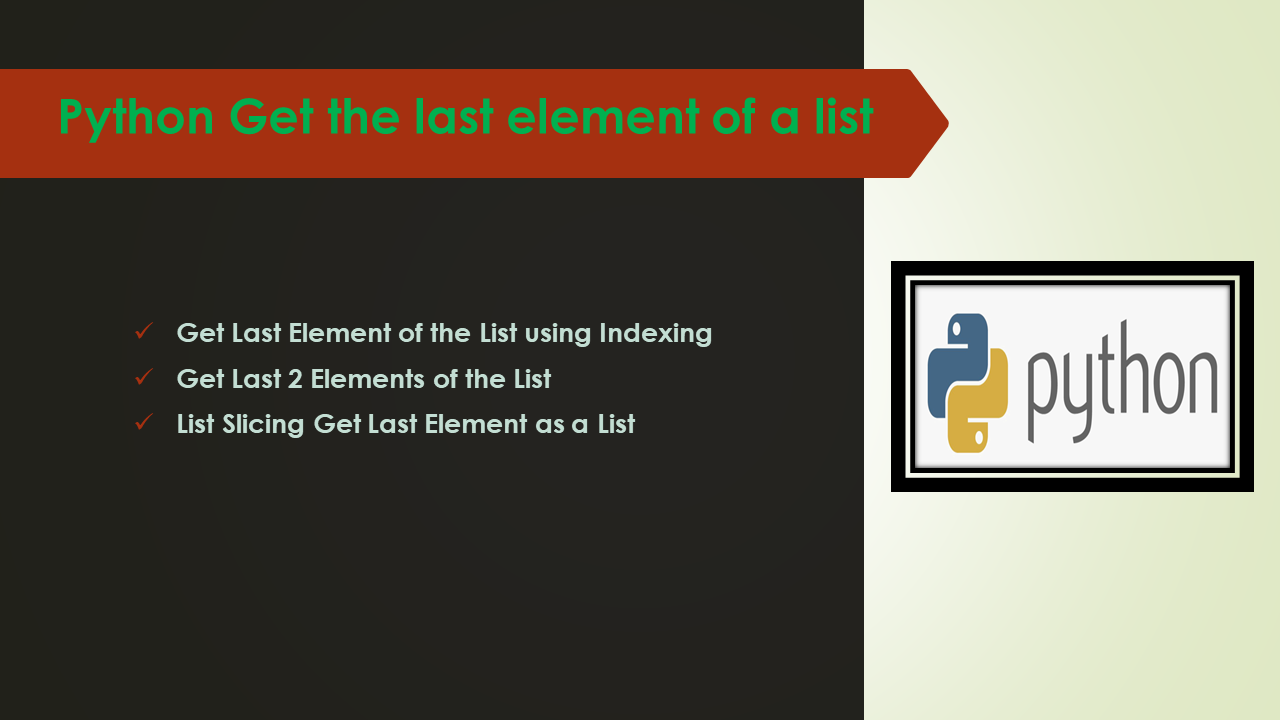Get Last Element of Python List: Easy Solutions
Learn different Python techniques to efficiently access and retrieve the last element from a list with clear examples.
Learn different Python techniques to efficiently access and retrieve the last element from a list with clear examples.
In Python, accessing the last element of a list is made easy with negative indexing. This feature allows you to traverse the list in reverse order, starting from the end. Let's explore how this works.
In Python, you can access the last element of a list by using negative indexing. Think of it like counting backwards from the end of the list.
Here's how it works:
Lists and Indexes: Lists are ordered collections of items. Each item has a position, called an index, starting from 0 for the first item.
Negative Indexing: Python allows negative indexes to access elements from the end. The index -1 represents the last element, -2 the second-to-last, and so on.
Example:
my_list = ["apple", "banana", "cherry"]
last_element = my_list[-1]
print(last_element) # Output: cherryIn this example, my_list[-1] directly fetches the last element ("cherry") without needing to know the list's length.
This Python code demonstrates accessing the last element of a list using negative indexing. It creates a list of fruits, retrieves the last element ("cherry") using my_list[-1], and then prints it.
my_list = ["apple", "banana", "cherry"]
# Accessing the last element using negative indexing
last_element = my_list[-1]
# Printing the last element
print(last_element) # Output: cherryExplanation:
my_list = ["apple", "banana", "cherry"]: This line creates a list named my_list containing three strings.
last_element = my_list[-1]: Here, we use negative indexing (-1) to access the last element of the list.
print(last_element): This line prints the value stored in the last_element variable, which is "cherry".
Key Point: Negative indexing provides a convenient way to access elements from the end of a list without needing to calculate the list's length beforehand.
my_list[-2] would give you "banana".len(): While you could use my_list[len(my_list) - 1] to get the last element, negative indexing (my_list[-1]) is much more concise and readable.my_list[-10] for a list of only three elements), you'll get an IndexError.| Feature | Description |
|---|---|
| Accessing Last Element | Use negative indexing in Python lists. |
| Negative Indexing | Starts from -1 for the last element, -2 for the second-to-last, and so on. |
| Example |
my_list[-1] retrieves "cherry" from ["apple", "banana", "cherry"]. |
| Advantage | No need to know the list's length beforehand. |
In conclusion, negative indexing in Python provides a powerful and efficient way to access elements from the end of lists, strings, and tuples. It simplifies code, enhances readability, and proves particularly useful in various algorithms and data manipulation tasks. By understanding and utilizing negative indexing effectively, programmers can write more concise and efficient Python code.
 Get the last element of a list in Python | Sentry | The Problem How do I get the last element of a list in Python? The Solution In Python, we can get the last element of a list using index notation. A positive…
Get the last element of a list in Python | Sentry | The Problem How do I get the last element of a list in Python? The Solution In Python, we can get the last element of a list using index notation. A positive… What is the easiest way to access the last element of a list? - Python ... | Question Is there a way to find the last item in a list without using the len() function? Answer The last item in a list can be found using the index value computed by len() - 1 for the list. A short-hand for this is to use an index value of -1. For any list, accessing the index of [-1] will return the last element of the list without needing to use the len() function. In the example below, both print() functions will output orange for the color. colors = ['red', 'green', 'blue', 'yellow', 'o...
What is the easiest way to access the last element of a list? - Python ... | Question Is there a way to find the last item in a list without using the len() function? Answer The last item in a list can be found using the index value computed by len() - 1 for the list. A short-hand for this is to use an index value of -1. For any list, accessing the index of [-1] will return the last element of the list without needing to use the len() function. In the example below, both print() functions will output orange for the color. colors = ['red', 'green', 'blue', 'yellow', 'o... Python | How to get the last element of list - GeeksforGeeks | A Computer Science portal for geeks. It contains well written, well thought and well explained computer science and programming articles, quizzes and practice/competitive programming/company interview Questions.
Python | How to get the last element of list - GeeksforGeeks | A Computer Science portal for geeks. It contains well written, well thought and well explained computer science and programming articles, quizzes and practice/competitive programming/company interview Questions. Python Get the Last Element of a List - Spark By {Examples} | Have you ever needed to get the last element of a list in Python, but weren't sure of the best way to do it? There are several different methods you can
Python Get the Last Element of a List - Spark By {Examples} | Have you ever needed to get the last element of a list in Python, but weren't sure of the best way to do it? There are several different methods you can Here is how to get the last element of a list in Python | To get the last element of a list in Python, you can use the index -1. You can also use the pop() method to remove and return the last element of a list.
Here is how to get the last element of a list in Python | To get the last element of a list in Python, you can use the index -1. You can also use the pop() method to remove and return the last element of a list. How do I get the last element of a list in Python? | Better Stack ... | Better Stack lets you see inside any stack, debug any issue, and resolve any incident.
How do I get the last element of a list in Python? | Better Stack ... | Better Stack lets you see inside any stack, debug any issue, and resolve any incident. 7 ways to Get the last element of a list in Python - Python Shiksha | Different methods by which we can get the last element of a list using Python
7 ways to Get the last element of a list in Python - Python Shiksha | Different methods by which we can get the last element of a list using Python Droping data with range of negitive indexes - Python Help ... | I’m working with list and list of list. I need to be able to address the data from both ways (right to left and left to right). This is needed when you have a list of lists AND need to address the last ‘sub’ list of the list of lists. Just groups of data. But we need to address the complete last dataset (sub list). Even if it is the first data sub list or the 50th. As it is now we lose data. data = [0, 1, 0, 0, 0, 1, 0, 0, 0, 0, 0, 0, 'test 3b', 'Lumpy', 0, 0, 45, 18, 24, 19,...
Droping data with range of negitive indexes - Python Help ... | I’m working with list and list of list. I need to be able to address the data from both ways (right to left and left to right). This is needed when you have a list of lists AND need to address the last ‘sub’ list of the list of lists. Just groups of data. But we need to address the complete last dataset (sub list). Even if it is the first data sub list or the 50th. As it is now we lose data. data = [0, 1, 0, 0, 0, 1, 0, 0, 0, 0, 0, 0, 'test 3b', 'Lumpy', 0, 0, 45, 18, 24, 19,...